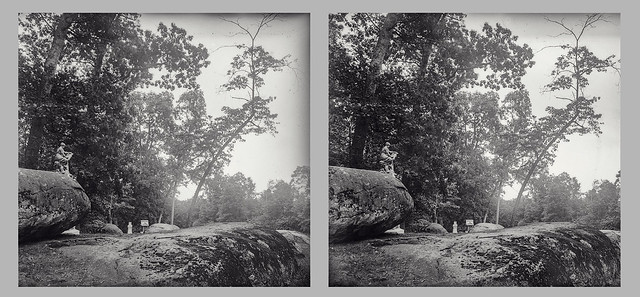largedrink
Down Under
First film back from the Edixa Stereo I viewfinder model. Some light leaks from the left lens. I can get the 3d effect through my stereo viewer but won't really be able to check them properly until printed. Maybe there's an alignment issue as some areas when viewed in 3d look a little distorted. Here are a couple:
Graveyard in Wellington
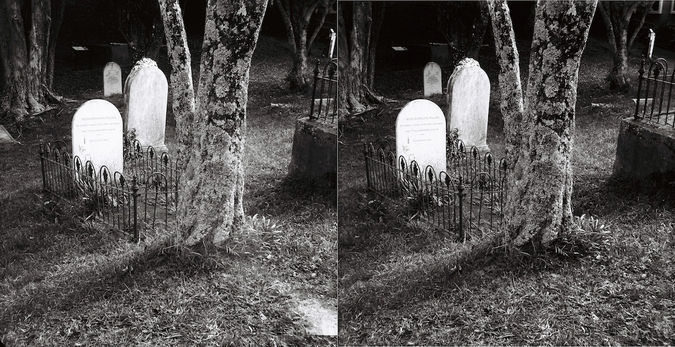
Swing bridge at Wall's Whare, Wairarapa, New Zealand
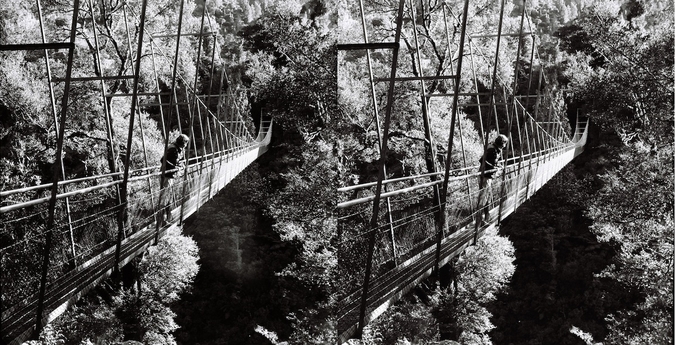
Graveyard in Wellington

Swing bridge at Wall's Whare, Wairarapa, New Zealand

Vince Lupo
Nobody's Mentor
Looks great - thanks for sharing!
Vince Lupo
Nobody's Mentor
This thing is seriously beautiful! I love the sculptural curve to the link between lenses; that just makes it so..... sexy!
Let’s just hope that my 120 adaptation worked!
Vince Lupo
Nobody's Mentor
First shot from the Lumiere Sterelux:

Lumiere Stereo1 by Vince Lupo, on Flickr
I had to run two test rolls of film through it, as I discovered that one of the lenses was not in correct focus. It's much better now, but still a little bit out. The other thing I discovered was a pinhole in the bellows -- a fabric pen fixed that issue. I had to make a wider rail for the lower edge of the film gate, as the film wasn't coming in contact with it. Now it has plenty of support top and bottom. The framing/numbering also seemed to work out fine -- the camera back has 7 separate windows and I had to figure out the proper spacing for 120 film. Frame 2 goes into window 1, then 3-5-7-9-11 go into window 5. The spacing is pretty tight but it does work out, only slight overlap in a couple of frames.

Lumiere Stereo1 by Vince Lupo, on Flickr
I had to run two test rolls of film through it, as I discovered that one of the lenses was not in correct focus. It's much better now, but still a little bit out. The other thing I discovered was a pinhole in the bellows -- a fabric pen fixed that issue. I had to make a wider rail for the lower edge of the film gate, as the film wasn't coming in contact with it. Now it has plenty of support top and bottom. The framing/numbering also seemed to work out fine -- the camera back has 7 separate windows and I had to figure out the proper spacing for 120 film. Frame 2 goes into window 1, then 3-5-7-9-11 go into window 5. The spacing is pretty tight but it does work out, only slight overlap in a couple of frames.
jankap
Established
Stereo photos (as anaglyphs) made with the Lytro Illum camera you can find in the Point-N-Shoot thread.
I missed this stereo thread until now. Thank you member largedrink!
Jan
I missed this stereo thread until now. Thank you member largedrink!
Jan
Vince Lupo
Nobody's Mentor
Vince Lupo
Nobody's Mentor
Polyscop lens and shutter assembly masterfully adapted to fit one of my Nil Meliors that had one bad lens.

Polyscop on Nil Melior by Vince Lupo, on Flickr
Maybe one of the most perfect stereo glass negs that I've done so far.

Polyscop Lenses1 by Vince Lupo, on Flickr

Polyscop Stereo1 by Vince Lupo, on Flickr
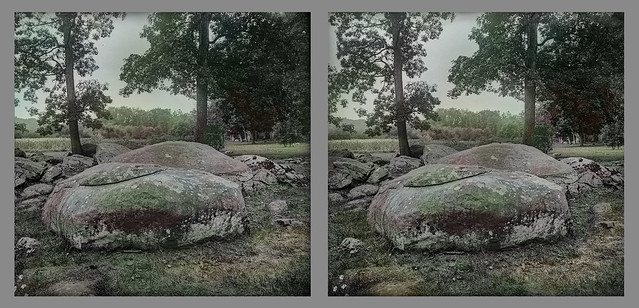
Polyscop Stereo1 Colorized by Vince Lupo, on Flickr

Polyscop on Nil Melior by Vince Lupo, on Flickr
Maybe one of the most perfect stereo glass negs that I've done so far.

Polyscop Lenses1 by Vince Lupo, on Flickr

Polyscop Stereo1 by Vince Lupo, on Flickr

Polyscop Stereo1 Colorized by Vince Lupo, on Flickr
Vince Lupo
Nobody's Mentor
Vince Lupo
Nobody's Mentor
I think this Nil Melior - Polyscop is turning out to be the best camera I have!
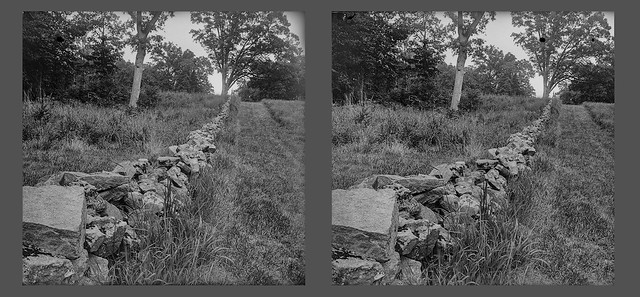
Polyscop3 Stereo by Vince Lupo, on Flickr

Polyscop3 Stereo Colorized by Vince Lupo, on Flickr

Polyscop3 Stereo by Vince Lupo, on Flickr

Polyscop3 Stereo Colorized by Vince Lupo, on Flickr
Vince Lupo
Nobody's Mentor
Vince Lupo
Nobody's Mentor
Vince Lupo
Nobody's Mentor
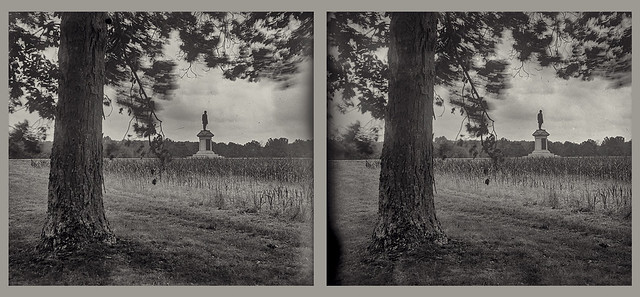
Abner Doubleday Stereo2 by Vince Lupo, on Flickr

Abner Doubleday Stereo2 Colorized by Vince Lupo, on Flickr
Vince Lupo
Nobody's Mentor
With the Lumiere Sterelux.

Gettysburg Train Stereo by Vince Lupo, on Flickr

Gettysburg Train Stereo Colorized by Vince Lupo, on Flickr

Empire Lady Stereo3 by Vince Lupo, on Flickr

Gettysburg Train Stereo by Vince Lupo, on Flickr

Gettysburg Train Stereo Colorized by Vince Lupo, on Flickr

Empire Lady Stereo3 by Vince Lupo, on Flickr
3D Steve
Newbie
So I’m assuming that they have slide mounts specific to that camera?
There was a whole 'set' that came with the Duplex - mounts, viewer, and most importantly, a dedicated cutter. People who buy the Duplex on its own try their hand at cutting the chips with scissors and fitting them into RBT mounts - but since the 120 film has no perforations, the pin bars on the RBT mounts cannot be utilized. Some people buy this camera mistakenly thinking that it is a medium format stereo camera.
Vince, the results you're getting with your various cameras are wonderful. It's great to see someone new to stereography explore different processes and cameras. There is a group of dedicated stereographers from all over the world that meet for 3D Conventions (The ISU and The NSA). This year's convention is online and virtual, of course. If you plan to shoot more slide film you should consider joining one of our medium format stereo folios. I belong to two of those. There is one managed by John Thurston, and one managed by Ian Andvaag. Ian also manufactures different types of medium format stereo mounts. The folios are traveling boxes of slides that make the rounds to all of the participants via the postal system. When a folio arrives at your house, you add up to four slides. Online you post thumbnails and descriptions of your submissions. Online you also leave comments for the other participants' slides. Then you send the box on its way to the next member. When the folio makes the rounds and returns to you, you remove your old slides, replace them with new ones, and start the process all over again. I'm not sure how much you'll be able to access if you're not a member, but here's some links that you might find useful:
https://stereo.thurstons.us/folio/
https://stereo.thurstons.us/
https://www.isu3d.org/
https://stereoworld.org/
Last edited:
3D Steve
Newbie
Since you're scanning all of your images anyways, you may want to download the free StereoPhotoMaker software. It will align your pairs of images for you, and you can save them in any stereo image format you wish.Gotcha - I guess I’ll have to scan each frame individually, not a big deal. I’ll try to just match up the spacing and size with an original stereo card.
This is very exciting
3D Steve
Newbie
The problem with stereo today in 2020 is that hardly anyone is willing to “do it” like it was meant to be. That is, slide film correctly mounted and looked at through a hand held viewer. Nearly everyone wants some digital BS wrapped into the affair. .....just put the electronics down and enjoy stereo the proper way.
As I mentioned in one of my replies above, there are a great number of us still working in stereo in the way it was meant to be. If you're shooting slide film still, perhaps you'd like to join the Gamma folio run by the NSA? The Gamma folio (which actually consists of four traveling boxes) is for 35mm stereo only. See my above reply for what participation in a folio entails. The only differences between the Gamma folio and the medium format folios is that the Gamma folio accepts one slide in each of the four boxes, and the comments are written on the envelope in which you encase your submission, old-school style.
Vince Lupo
Nobody's Mentor
Many thanks for your comments Steve! I'll be sure to have a look at those links you suggested.
As far as the cameras I'm using, I'm tending to settle into the glass plate / 120 film region, and not so much on the 35mm (though I definitely see the benefits of the Revere for convenience, etc). Somehow I prefer the unfettered torture and occasional frustration of the glass plates
In a way I'm almost disappointed that the Sterelux has turned out to be so straightforward and trouble-free!
As far as the cameras I'm using, I'm tending to settle into the glass plate / 120 film region, and not so much on the 35mm (though I definitely see the benefits of the Revere for convenience, etc). Somehow I prefer the unfettered torture and occasional frustration of the glass plates
In a way I'm almost disappointed that the Sterelux has turned out to be so straightforward and trouble-free!
3D Steve
Newbie
Many thanks for your comments Steve! I'll be sure to have a look at those links you suggested.
As far as the cameras I'm using, I'm tending to settle into the glass plate / 120 film region (snip)
In a way I'm almost disappointed that the Sterelux has turned out to be so straightforward and trouble-free!
The Sterelux looks like a beautiful camera and does produce great results! I'll have to keep my eye out for one. Hopefully you'll join one or both of the medium format stereo folios and share some of your 120 film results!
From what I understand, the Sterelux uses 116 film; did you use adapters and use 120 film, or did you adapt 70mm film somehow?
Last edited:
Vince Lupo
Nobody's Mentor
The Sterelux looks like a beautiful camera and does produce great results! I'll have to keep my eye out for one. Hopefully you'll join one or both of the medium format stereo folios and share some of your 120 film results!
From what I understand, the Sterelux uses 116 film; did you use adapters and use 120 film, or did you adapt 70mm film somehow?
I use the 116 to 120 spool adapters, plus I added two thin strips of metal along the top and bottom edges of the film gate for film edge stability. Seems to work fairly well - the only real challenge was to figure out the film frame spacing, as there are 7 separate red windows on the camera’s back for frame indication. I had to run a test roll of film through a few times and mark off the frames with a marker to determine which frame should fit into which window.

Sterelux Back by Vince Lupo, on Flickr
Frame #2 goes to window #1, then frames 3-5-7-9-11 go to window #5. Pretty straightforward.
Vince Lupo
Nobody's Mentor
Two shots with the Philippe Tiranty Verographe (sorry for the torn emulsion in the right-hand stereo shot:

Poffenberger Farm Stereo by Vince Lupo, on Flickr

Poffenberger Farm Stereo Colorized by Vince Lupo, on Flickr
And in Panorama Mode using the full width of the 6x13 plate:

Bloody Lane Panorama by Vince Lupo, on Flickr
The camera seems to work fine now, though that shutter mechanism is really fragile. It's such a quiet shutter that you have to listen really carefully to confirm that you did in fact trip it. This camera in particular is really sensitive to the cable release that you use - I had to try three different ones before I found the work that worked reliably with it. Frank Marshman went through this camera pretty thoroughly and rebuilt virtually the entire shutter mechanism, so I think it's as good as it's going to be.

Poffenberger Farm Stereo by Vince Lupo, on Flickr

Poffenberger Farm Stereo Colorized by Vince Lupo, on Flickr
And in Panorama Mode using the full width of the 6x13 plate:

Bloody Lane Panorama by Vince Lupo, on Flickr
The camera seems to work fine now, though that shutter mechanism is really fragile. It's such a quiet shutter that you have to listen really carefully to confirm that you did in fact trip it. This camera in particular is really sensitive to the cable release that you use - I had to try three different ones before I found the work that worked reliably with it. Frank Marshman went through this camera pretty thoroughly and rebuilt virtually the entire shutter mechanism, so I think it's as good as it's going to be.
Share:
-
This site uses cookies to help personalise content, tailor your experience and to keep you logged in if you register.
By continuing to use this site, you are consenting to our use of cookies.





